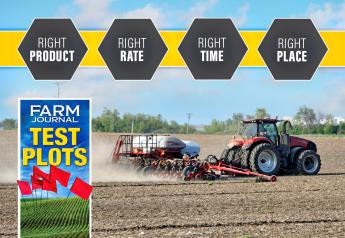Valley Agronomics Named Precision Impact Award Recipient

Every retail operation has charted its own course in pairing agronomy services with digital ag tools.
During the past two years, the team at Valley Agronomics LLC has been building a foundation with its Platinum Precision product. This subscription-based service builds a bridge for farmer-customers by linking the agronomists and the precision ag team at the retailer.
“We have three goals with our precision ag offerings: grow more yield, reduce costs, and make life easier,” says precision ag manager Connor Lankford. “The third is sometimes the easiest to prove, so it’s really on us to demonstrate how we’ve impacted yields and costs using technology.”
With their service-minded approach, Lankford and Valley Agronomics were recognized as the 2018 recipient of the Precision Impact Award, sponsored by Proagrica, the Agricultural Retailers Association and AgPro.

In developing Platinum Precision, Lankford (right, with customer Tanner Wahlen) and his team sat down with growers to learn more about their pain points with adopting technology. “The constant feedback from farmers was that they weren’t sure they wanted to be the ones to figure out all of the technology options and how it could fit their farm,” Lankford explains. “So we knew this had to be about selling them a service—not just a set of products.”
In forming a standard offering with Platinum Precision, growers are engaged with tools from which the precision ag team is confident growers can reap benefits. It also allows growers to try new technologies at a lower risk and with the full support of Valley Agronomics’ three-person precision ag team. With 24 retail locations, Valley Agronomics serves 5,000 farmers in Idaho, Oregon, Washington, Utah and Nevada.
“Among the disruptions we could see coming is that technology is going to become a bigger and bigger factor in helping growers be successful,” says chief operating officer Richard Lloyd, “whether it’s tracking their inputs to the field level and being able to report that back to their customers and consumers or whether it is being able to use new technology such as drones, artificial intelligence and satellite imagery so they can see what’s happening in the field and address it more effectively.”
As a retailer, the company is able to demonstrate a return on investment on farms while decreasing the risk of trying out new technologies for each individual farmer.
“We wanted to launch something that provided a low-risk environment for growers who were looking at trying some of the new technologies without having to worry about some being a bit unproven or a bit expensive,” Lloyd says. “In doing so, we figured out a way to bring a low-cost way for growers to collaborate with us, so we can learn together and then scale technology adoption over enough acres to really prove value to the growers.”
The fee for Platinum Precision is $2,500 per year per grower. The subscription has five facets:
- Farm management software
- Variable-rate map creation
- Satellite images for whole farms
- Yield map retrieval
- $1,000 credit toward a farmer’s choice of nine other services
So far, the company has worked with 220 growers across 900,000 acres in Idaho, Utah and Oregon. And the crops for which the technologies have been used to inform decisions include corn, soybeans, wheat, hay, hops, mint and onions.
For Kim Wahlen Farms, a 12,000-acre operation outside of Aberdeen, Idaho, the payback is immediate, but the farm has a focus on the future of where technology is headed.
“Being a Platinum Precision subscriber gives us the benefits of all the record-keeping software, which is key to help us understand our daily tasks and keep track of everything we do and quantify it,” says Tanner Wahlen, who helps manage the farm’s day-to-day operations.
Wahlen also credits the record keeping with helping the farm get a handle on sustainability.
“We’re able to submit all of our data to processors because it’s all streamlined,” Wahlen says. “Sustainability is a big word now, and our use of precision ag helps us measure how we’re trying to produce the crops sustainably—from aerial imagery to soil maps.”

From the 2018 package to the 2019 package, the precision ag team changed some of the services and products in the lineup based on in-field experience, new introductions and grower feedback. Lankford and Lloyd say the subscription includes products they know deliver value and some that have yet to be fully vetted.
“What we know is that technology is changing really fast. By partnering in the Platinum Precision program, it allows us to help growers be flexible and navigate the changing environment and be winners with precision ag,” Lloyd says. “It’s not just about one aspect of the program, one company, one software or one service. We’ve been able to assemble many different aspects of precision agronomy and technology,” he adds.
Valley Agronomics has found the overlap in how technology services can help support customer retention and input sales. For example, the team has found remote sensing, both satellite images and ultra-high-resolution images from fixed-wing airplanes, provides farmers an advanced warning tool for agronomic issues, so they can specifically send scouts or agronomists to assess those issues.
“Another example is in grass seed production. We’ve been able to use high-resolution images to create zone maps for variable-rate plant growth regulator applications,” Lankford explains. “We’re able to base the rates on biomass indexes, and we’ve seen a nice ROI for our growers on that.”
Lankford explains the internal teamwork with Platinum Precision is an example of tying digital tools to agronomy, which can demonstrate how the team is the best-in-class local expert.
“Overall, our strategy is to be convenient and be the customer’s supplier of choice for agronomy because we’re so convenient,” Lankford says. “Each grower is unique, and by bringing everything we do to the table, we’re able to tailor custom solutions to each grower’s operation, and our agronomists play a key role in helping decipher and use all of the information to their advantage.”
As one customer success example, a potato grower in southern Idaho found the subscription to the suite of services to pay off. Lankford notes the grower had a field with a large blow sand ridge all through it. Other areas of the field were heavy clay.
“We couldn’t keep enough nitrogen applied to the plants in the sand ridge,” he says. “This farmer was a Platinum Precision subscriber, so he had access to the EC mapping and soil sampling, so we were able to exactly delineate where the ridge was. We also created management zones for variable-rate prescriptions. In the past year, the yields were better than ever before, and the fertilizer costs were also reduced on the overall field.”
Lankford attributes the set of tools available in Platinum Precision to creating heightened engagement with growers because they know the Valley Agronomics team will support them in how to use the technology tools without overwhelming them in the process.
Lloyd says Platinum Precision is an example of what the business has learned about serving farmers with technology. “Over the last several years, we’ve seen that technology can be a tool, but it can be overwhelming to growers if it’s just sold as a technology product. We really feel like being the trusted adviser led us to incorporate technology as a service,” Lloyd says.







